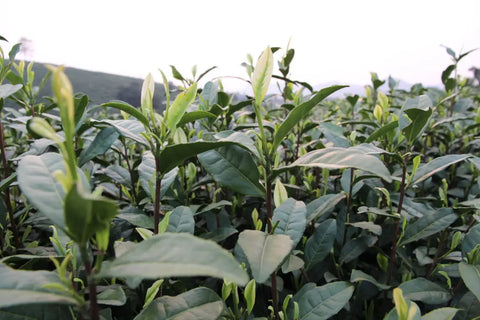You’ve probably heard of White Tea, which includes varieties like Silver Needles, White Peony, and Shou Mei. But there’s another tea called Anji Bai Cha—literally "Anji White Tea" in English. Despite its misleading name, it’s not actually a white tea at all! In fact, Anji Bai Cha is a type of green tea and one of the most renowned green teas from China.

The Book on tea from an emperor in Song dynasty
Around a thousand years ago, during the Song Dynasty, Emperor Song Hui Zong wrote a fascinating book called The Daguan Book of Tea, or The Daguan Analysis of Tea. In it, he described a rare and special type of white tea, unlike any other tea known at the time. He wrote, “There is a white tea that grows among rocks and forests. It has only two or three leaves, and the leaves are so thin and translucent, like jade—unparalleled and beyond the skill of human hands.*” After the Song emperor’s time, this mysterious tea seemed to vanish from history. No one knew where it grew, what it looked like, or even how it tasted. But in the late 20th century, researchers discovered a tea tree in Anji County, Zhejiang Province, and confirmed that it was indeed the very tea described by the Song emperor in his book.
* Translation by Victoria Wu
See the picture below. Victoria sitting in front of the one thousand year-old mother bush of Anji Bai Cha tea tree.

So what makes Anji Bai Cha so special?
Anji Bai Cha is a unique tea variety, distinguished by its tendency for the leaves to take on a whiter hue rather than the typical green. This gives the tea its name, "Anji Bai Cha," which means "Anji White Tea." In early spring, due to its lower chlorophyll content, the tender leaves harvested in early April often appear yellowish-white. After processing, the finished leaves retain a pale jade color, setting them apart from the bright green of other green teas. This characteristic is what makes Anji Bai Cha so special.


However, despite its lighter appearance, Anji Bai Cha is still processed using traditional green tea methods, so it is classified as a green tea, not a white tea.
Unlike other green teas, which can be harvested throughout the spring, Anji Bai Cha has a narrow harvest window, usually before April 15th. In Anji County, there are two main types of green tea: one is the true Anji Bai Cha, with its white-tinged leaves, and the other is a more common green tea made from a different varietal. You can see the difference in the leaves in the photo from Victoria’s sourcing trip. Both are technically green teas, but Anji Bai Cha, with its distinctive white leaves is the exceptional, prized variety that we offer. The other green varietal, often found flooding the market, is a more standard green tea.

The two types—Anji Bai Cha and regular Anji green tea—are sometimes confused in the marketplace, especially when it comes to pricing. The leaves of both varietals may look similar at first glance, but as you can see in the side-by-side comparison in the photo, there’s a clear difference. The white-leafed Anji Bai Cha is the real gem, offering a sublime, delicate flavor that stands apart from the more common green tea.
The Feast of the Taste Buds
This tea has a bright, vegetal note that brings an uplifting freshness, along with a subtle umami that lingers on the palate, reminiscent of a comforting taste of a perfectly brewed vegetable broth. The undertone of umami adds a smooth, satisfying depth to the tea, offering a harmonious blend of fresh and savory.

Because Anji Bai Cha has richest amino acid content among all other green teas, almost 3 times of regular green teas, the taste is very fresh with very little bitterness. Because of this, it is good for cold brewing as well. Brewing Anji Bai Cha is very forgiving, with very little bitterness, unlike some other green teas. Because of this, we recommend brewing it in a range of 180-190 degree water, never with boiling water or tap water. The chemicals in the tap water will greatly reduce the freshness and delicate texture in the tea liquor. Owing to its abundance of amino acids, richest of all green teas, it also helps to reduce stress and promote relaxation.







Leave a comment